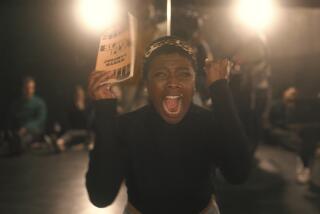Harris’ ‘Soul’ Tied Down by Excessive Literalism
Using the physical and emotional linkages between conjoined twins as a metaphor, choreographer Winifred R. Harris’ “In Soul We Mate” invites us to look at connection, responsibility and the ties that bind.
But this daring, new two-act project, at the John Anson Ford Amphitheatre on Saturday, suffers from needless literalism. For far too long, members of Harris’ locally based Between Lines company must dance attached to life-size mannequins or head-effigies.
And if the result forces Harris to extend herself beyond her usual sculptural modern dance style, it also promulgates the notion that the life of conjoined twins involves a sentient being burdened by dead weight: their relationship as the old ball-and-chain.
Not for the first time, a failure of theatrical imagination has undercut her purposes. In a dance concert by Sen Hea Ha at Highways the same weekend, a long, gnarled wooden pole became a magical extension of the dancer’s body and a full partner in her actions. In “The Lion King” on Broadway, choreographer Garth Fagan and director Julie Taymor make puppets and puppeteers equally vibrant and capable of independent motion. But “In Soul We Mate” only comes alive when the dutiful doll-dancing ends, and conjoined twins are depicted by pairs of dancers united by costuming ploys (a belt connecting their chests, for example, or a shared pant leg).
*
Here the complexities of physical union yield potent duets, especially a deft, dignified biographical portrait (“Labor of Love”) danced by Miko Doi-Smith and Claudia Medina with enough deep fervor to raise sisterhood high on the list of cardinal virtues.
The finale (“Separation”) juxtaposes eight women, identically costumed in turquoise and white but with individual movement identities gradually accommodated and absorbed in eloquent, expansive unison. As in “A Chorus Line,” Harris shows how much a shared statement can cost as well as how satisfying it can be, how it affirms something greater than mere diversity.
Even if it represents a conventional fallback from the ambitious, problematic experimentation earlier, this finale not only shows off Harris’ augmented company handsomely but also draws a curtain over all the traps and lapses on view before.
It’s Harris back on track, and it finds her dancers not merely coping with physical challenges but transcending them.
Ed Barguiarena’s accessible, jazzy score (played live) also helps lighten Harris’ murkier episodes, though the passages of extended interplay between the seven musicians may have forced her into the cyclical repetitions that further weaken some sequences.
*
Harris remains a valiant, original force in local modernism, and “In Soul We Mate” represents evidence of her artistic growth. But she should consider working with a stage director or dramaturge who shares her concepts and might help her realize them more expertly than she can do alone.
Besides Harris herself, the most intense solos Saturday went to the commanding Myshia Moten. Other company dancers include Kristy Campbell, Danielle Lewis, Fiona Manners, Tracey White and Adrian Young. The supporting cast enlists children from the L.A. Academy of Fine Arts and Cesar Chavez Elementary School, along with members of the Between Lines scholarship program.
More to Read
The biggest entertainment stories
Get our big stories about Hollywood, film, television, music, arts, culture and more right in your inbox as soon as they publish.
You may occasionally receive promotional content from the Los Angeles Times.










